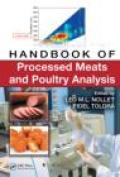
This book describes essential techniques for meat processing control and evaluation of quality. Muscle foods include a wide range of processed meats and poultry, and therefore represent an important percentage of total worldwide foodconsumption. The sheer volume of products and the variety of processes available makes analyzing them problematic. With chapter contributions from more than 45 internationally reputable experts, "Handbook of Processed Meats and Poultry Analysis" delineates the gamut of analysis techniques and methodologies foranimal-derived products in one convenient resource.This book focuses on the analysis of nutrients affected by processing and provides an all-inclusive examination of the nutritional qualities of meat products and poultry. It discusses determination methods of biochemical reactions, including Oxidation, Proteolysis, and Lipolysis. Under the editorial guidance of world-renowned food analysis experts Leo M.L. Nollet and Fidel Toldra, this book describes the analysisof technological quality, such as physical sensors and techniques to follow up the process and the analysis of moisture and water activity. It also addresses key treatment areas such as: Additives such as preservatives and colorants;Methods to measure meat's antioxidant capacity; Spoilage detection; and, Analytical tools for finding chemical residues, pathogens, and toxins.This comprehensive reference addresses a variety of products, processes, and treatments related to meat preparation including curing and dry-curing, fermentation, cooking, and smoking. It also acutely analyzes the technological, nutritional, and sensory quality as well as the safety aspects of these and other processes. With a section entirely devoted to pressing safety concerns related to meat processing, this is an essential, ready-to-implement guide for those involved withthe processing of muscle foods in both academia and industry. INDICE: PROCESSING CONTROL. Introduction: Importance of Analysis in Meat Products. Physical Sensors and Techniques. Moisture and Water Activity. Ingredients: Meat, Fat, and Salt. Additives: Preservatives. Additives: Smoke Flavorings. Colorants. Determination of Oxidation. Determination of Proteolysis. Determination of Lipolysis. NUTRITIONAL QUALITY. Composition and Calories. Essential Amino Acids. Omega-3 and Trans Fatty Acids. Methods to Measure the Antioxidant Capacity of Meat Products. Vitamins. Minerals and Trace Elements in Meat Products. SENSORY QUALITY. Color Characteristics of Meat and Poultry Processing.Texture Analysis. Flavor of Meat Products. Sensory Descriptors of Cooked MeatProducts. Sensory Descriptors for Dry-Cured Meat Products. SAFETY. Spoilage Detection. Microbial Foodborne Pathogens. Mycotoxin Analysis in Poultry and Processed Meats. Detection of Genetically Modified Organisms in Processed Meats and Poultry. Detection of Adulterations: Addition of Foreign Proteins. Detection of Adulterations: Identification of Animal Species. Residues of Food ContactMaterials. Polychlorinated Biphenyls: Environmental Chemical Contaminants in Muscle Food. Veterinary Drug Residues. Biogenic Amines. Nitrosamines. Polycyclic Aromatic Hydrocarbons. Detection of Irradiated Ingredients. Index.
- ISBN: 978-1-4200-4531-4
- Editorial: CRC Press
- Encuadernacion: Cartoné
- Páginas: 763
- Fecha Publicación: 01/11/2008
- Nº Volúmenes: 1
- Idioma: Inglés
